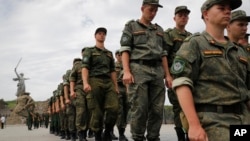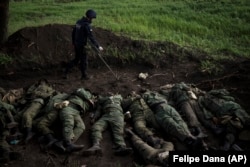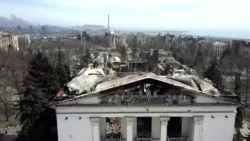Six months in, Russia needs soldiers.
Tallies of Russian military casualties since the invasion of Ukraine was launched in February vary. U.S. officials put Russia’s dead and wounded at between 70,000 and 80,000, a figure echoed by British and other Western intelligence estimates.
For months now, Russian commanders and recruiters have been conducting a quiet but sweeping campaign to find more men to replenish the ranks.
State TV newscasts have shown telephone numbers where volunteers can call to get information about joining what the Kremlin calls its "special military operation.” Lawmakers have removed the upper age limit for men to serve under contract. Headhunter websites are littered with vacancies for "contract soldiers” with lucrative wages and benefits.
Officials reportedly want to create "volunteer battalions" in every one of Russia’s 80-plus regions. Reports say private mercenary companies are offering convicted inmates reductions in sentences in exchange for signing up. Conscripts, who are barred from serving in combat, are being coerced into signing contracts to extend service.
One thing the Kremlin and the Defense Ministry have refused to do, however, is declare a general mobilization, a move that could smash Russian society’s tacit acceptance of the war and the Kremlin’s stated aims.
On August 25, though, President Vladimir Putin took a smaller -- but consequential -- step to pull Russians deeper into the war.
In a decree published on the Kremlin website, Putin ordered a substantial hike in the number of active-duty soldiers: an increase of 13 percent, or 137,000 troops, for a total of 1.15 million.
The order, which takes effect January 1, ushers in the first change in the overall size of the military in five years. No explanation accompanied it. Neither the Kremlin, nor Putin, nor the Defense Ministry uttered a word about it in public.
“The Kremlin’s biggest concern in fighting the war in Ukraine right now is manpower,” said Oscar Jonsson, a researcher at the Swedish Defense University in Stockholm.
“This appears to be a way to make the current hodgepodge of the different ways to boost the official figures…more permanent than temporary, and also yet another way of avoiding a general mobilization,” he said.
The increase will bring the overall military and civilian personnel in the armed forces to more than 2 million. But the increase will only come from adding new soldiers, not new civilians.
Casualties Of War
Prior to the February 24 invasion, Western analysts put the overall size of Russia’s armed forces at around 850,000 to 900,000, though officially the stated number was over 1 million. Prewar intelligence analyses said Russia had deployed around a total of 170,000 troops to the regions near Ukraine’s borders in the run-up to the invasion.
In the first months after the invasion, Russia’s invading forces failed spectacularly on several fronts, including an early effort to seize the capital, Kyiv, that was repulsed by fierce resistance from Ukrainian troops.
Russian troops seized the port city of Mariupol after a brutal siege that leveled much of the city.
WATCH: Aerial footage captures contrasting images of the city of Mariupol before and after February 24, when Russia launched its military invasion of Ukraine. The once vibrant industrial seaport has since become a symbol of utter and indiscriminate devastation inflicted by Russian bombardment.
That then led to Russian commanders taking an “operational pause,” shifting men and materiel withdrawn from around Kyiv and other areas to the Donbas, and reorganizing command structures. The move has yielded slow, incremental gains.
More recently, the tempo of fighting in the Donbas has slowed, to a near stalemate, and attention has turned to Ukraine’s south, where there are signs of a nascent Ukrainian counteroffensive targeting Russian troops in Kherson, and possibly Zaporizhzhya.
My impression so far is that [Putin] really dislikes the idea of officially forcing people to go to war. Pressuring them in various ways or tempting them with money, yes, but declaring to the entire population that there is no longer a choice, no.”-- Tor Bukkvol, Norwegian Defense Research Establishment
Meanwhile, problems with Russia’s on-the-ground operations have come into sharper focus, with reports of mounting casualties, equipment failures, and soldiers refusing to fight -- or even units fighting one another.
Experts say a flood of powerful modern weaponry from the United States and European countries have helped Ukrainian troops batter Russian supply lines and command posts.
Buckling Down
The last official casualty tally released by Russia came in late March, when the Defense Ministry announced 1,351 troops had died in the fighting. There have been no other updates since.
For its part, Ukraine, which has essentially mobilized the entire country and forbidden fighting-age men from leaving, has also suffered heavy losses. Last week, the Ukrainian military’s commander in chief said nearly 9,000 troops have been killed since February 24, a number that is likely an undercount.
Putin’s decree and the troop increase suggest that the Kremlin is buckling down for a long war in Ukraine, said Tor Bukkvol, a longtime Russia military expert at the Norwegian Defense Research Establishment.
“But could not this decree equally be seen as an attempt to try to make sure he will have enough troops without having to go to a mobilization?” Bukkvol said in an e-mail. “My impression so far is that he really dislikes the idea of officially forcing people to go to war. Pressuring them in various ways or tempting them with money, yes, but declaring to the entire population that there is no longer a choice, no.”
Russia’s training and recruitment infrastructure is likely unable to handle a general mobilization that would mean processing, equipping, and deploying tens of thousands of soldiers, Bukkvol said.
“A steady increase in personnel within existing units may be easier to handle,” he said.
The number of troops specified in the increase -- 137,000 -- also matches up with the size of the two draft cycles that occur biannually under normal peacetime conditions, Jonsson said. Under Russian law, all men between the age of 18 and 27 are required to serve a year in the military, and there are two draft periods -- one in the spring, and one in the autumn -- that each typically conscripts around that number of men.
'Obviously Desperate'
Another explanation is that the Kremlin drafted this decree to serve as the legal framework for all the various “hodgepodge” recruitment efforts, said Nick Reynolds, a land-warfare research analysts at the Royal United Services Institute in London.
“To my mind, it merely facilitates their current attempts to attract recruits and bring them into military service by providing legal cover and additional budget for any expansion,” Reynolds said.
“Russia is obviously desperate to bolster its military manpower and has continued to rely upon reenlisting veterans and reservists with some military experience to replenish their losses, and leveraged those who have worked on the international private security contractor circuit,” he said.
The Kremlin still considers mobilization a risky proposition, Reynolds said.
That’s why the replenishment efforts have involved things like increased conscriptions in the Luhansk and Donetsk regions that have been largely under Russian control since 2014. And, Reynolds pointed out, there are reports that Russia’s most notorious private mercenary company, the Vagner Group, has begun recruiting inmates from prisons.
“These initiatives seem to still be the preferred methods of expanding their manpower,” he said. “But yes, recognizing that the war will not be over any time soon is also a factor, and things could change in future.”














